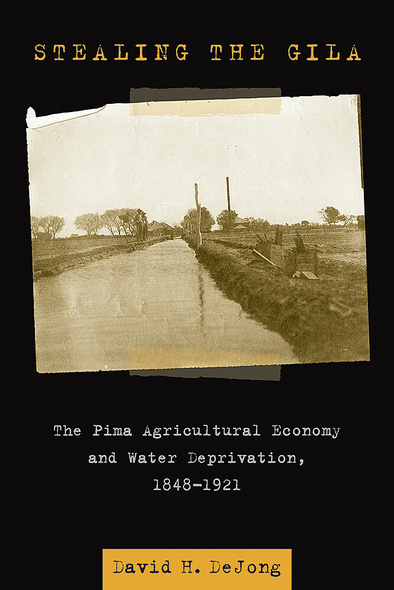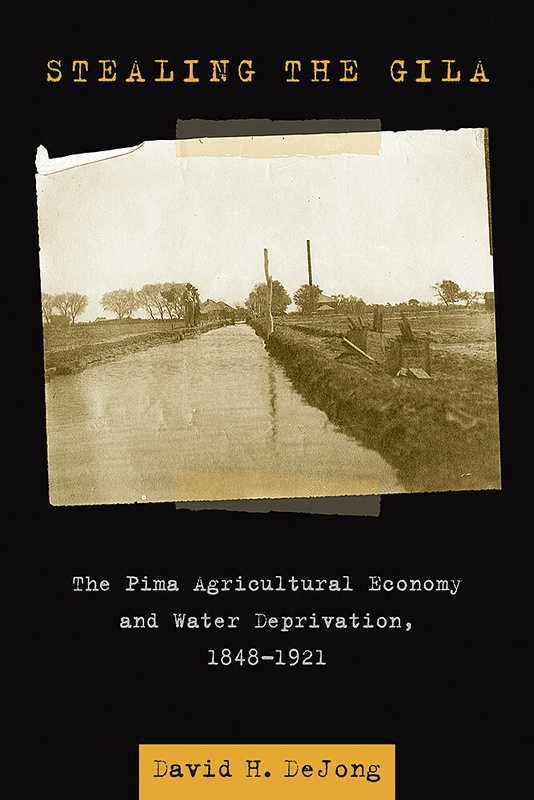
272 pages, 6 x 9
16 b&w illustrations, 9 maps, 11 tables
Paperback
Release Date:15 Sep 2016
ISBN:9780816535583
Stealing the Gila
The Pima Agricultural Economy and Water Deprivation, 1848-1921
The University of Arizona Press
By 1850 the Pima Indians of central Arizona had developed a strong and sustainable agricultural economy based on irrigation. As David H. DeJong demonstrates, the Pima were an economic force in the mid-nineteenth century middle Gila River valley, producing food and fiber crops for western military expeditions and immigrants. Moreover, crops from their fields provided an additional source of food for the Mexican military presidio in Tucson, as well as the U.S. mining districts centered near Prescott. For a brief period of about three decades, the Pima were on an equal economic footing with their non-Indian neighbors.
This economic vitality did not last, however. As immigrants settled upstream from the Pima villages, they deprived the Indians of the water they needed to sustain their economy. DeJong traces federal, territorial, and state policies that ignored Pima water rights even though some policies appeared to encourage Indian agriculture. This is a particularly egregious example of a common story in the West: the flagrant local rejection of Supreme Court rulings that protected Indian water rights. With plentiful maps, tables, and illustrations, DeJong demonstrates that maintaining the spreading farms and growing towns of the increasingly white population led Congress and other government agencies to willfully deny Pimas their water rights.
Had their rights been protected, DeJong argues, Pimas would have had an economy rivaling the local and national economies of the time. Instead of succeeding, the Pima were reduced to cycles of poverty, their lives destroyed by greed and disrespect for the law, as well as legal decisions made for personal gain.
This economic vitality did not last, however. As immigrants settled upstream from the Pima villages, they deprived the Indians of the water they needed to sustain their economy. DeJong traces federal, territorial, and state policies that ignored Pima water rights even though some policies appeared to encourage Indian agriculture. This is a particularly egregious example of a common story in the West: the flagrant local rejection of Supreme Court rulings that protected Indian water rights. With plentiful maps, tables, and illustrations, DeJong demonstrates that maintaining the spreading farms and growing towns of the increasingly white population led Congress and other government agencies to willfully deny Pimas their water rights.
Had their rights been protected, DeJong argues, Pimas would have had an economy rivaling the local and national economies of the time. Instead of succeeding, the Pima were reduced to cycles of poverty, their lives destroyed by greed and disrespect for the law, as well as legal decisions made for personal gain.
A highly readable, well-researched study that deserves examination by all who are interested in social and political aspects of Native American history.’—Indigenous Peoples Issues and Resources
David H. DeJong holds MA and PhD degrees in American Indian Policy Studies from the University of Arizona. Having written dozens of articles and two books dealing with federal Indian policy, DeJong is currently the Project Manager of the Pima-Maricopa Irrigation Project, a construction project funded by the U.S. Bureau of Reclamation and designed to deliver water—from the Central Arizona Project, the Gila River, and other settlements—to the Gila River Indian Reservation.
List of Maps
List of Tables
Acknowledgments
Introduction: A West of Jeffersonian Farmers?
1 The Prelude
2 The Pima Villages and California Emigrants
3 Establishment of the Pima Reservation
4 Civil War, Settlers, and Pima Agriculture
5 A Crisis on the River
6 Famine and Starvation
7 Allotment of the Pima Reservation
8 The Pima Adjudication Survey
9 The Florence–Casa Grande Project
10 The Pima Economy, Water, and Federal Policy
Notes
Bibliography
Index




